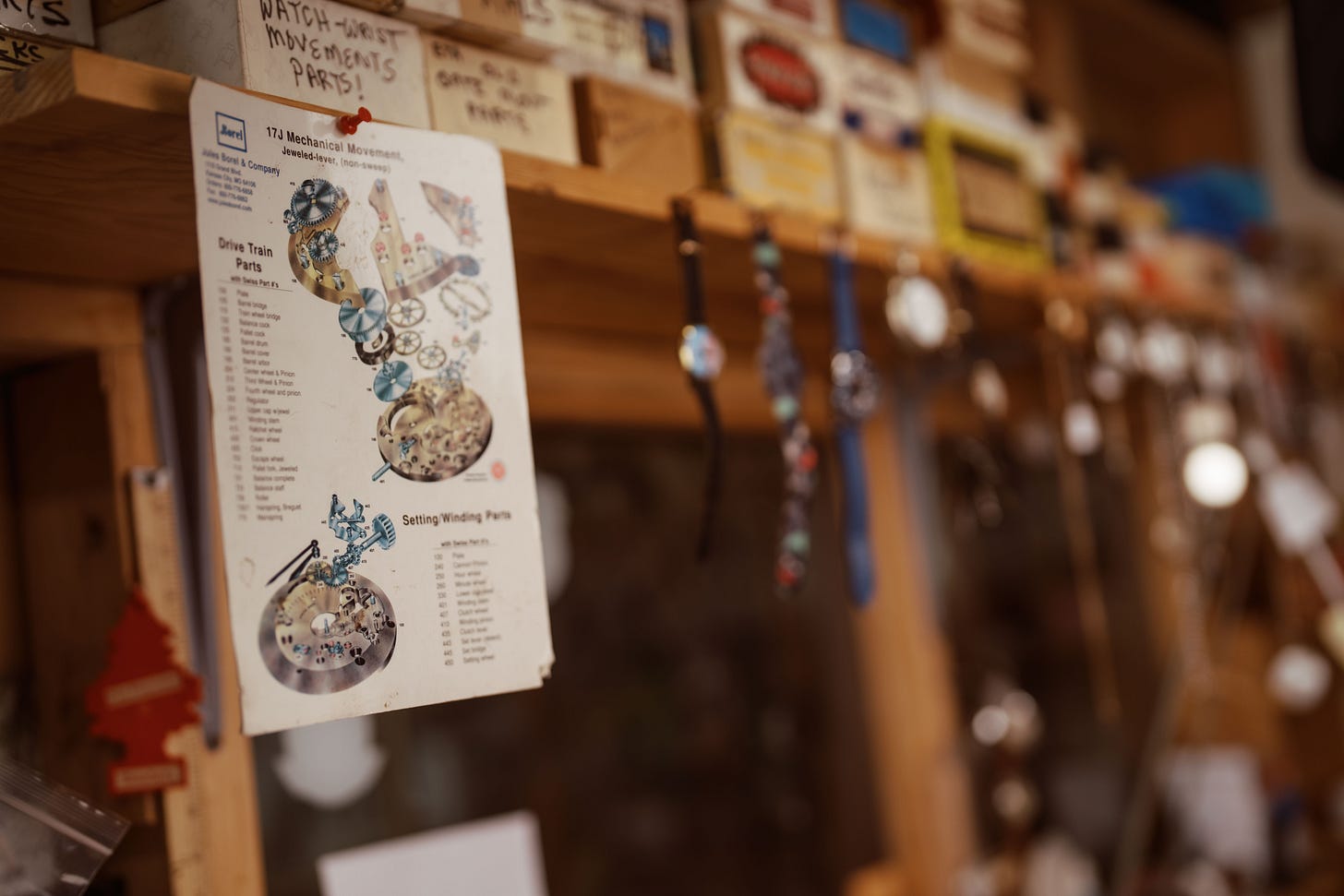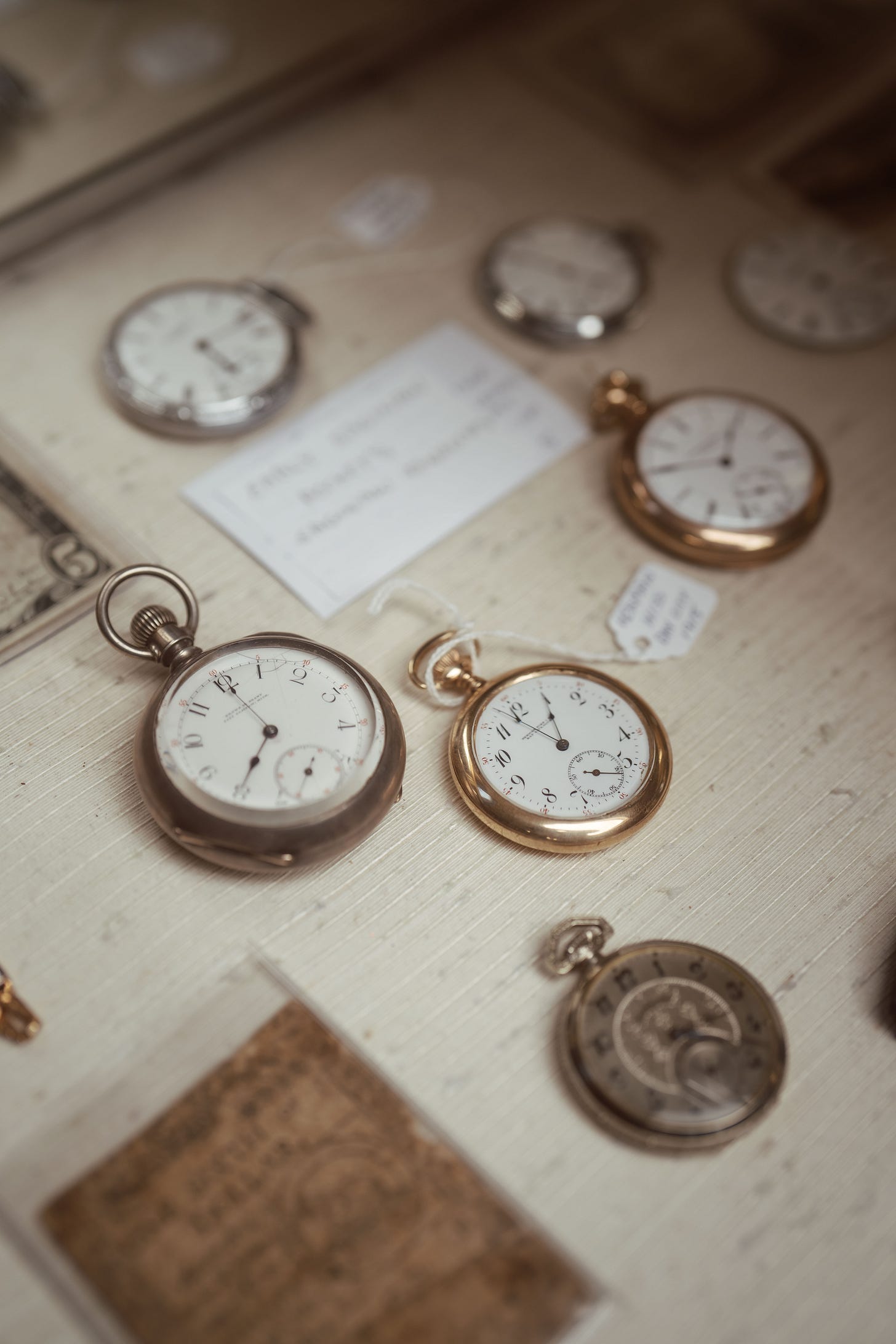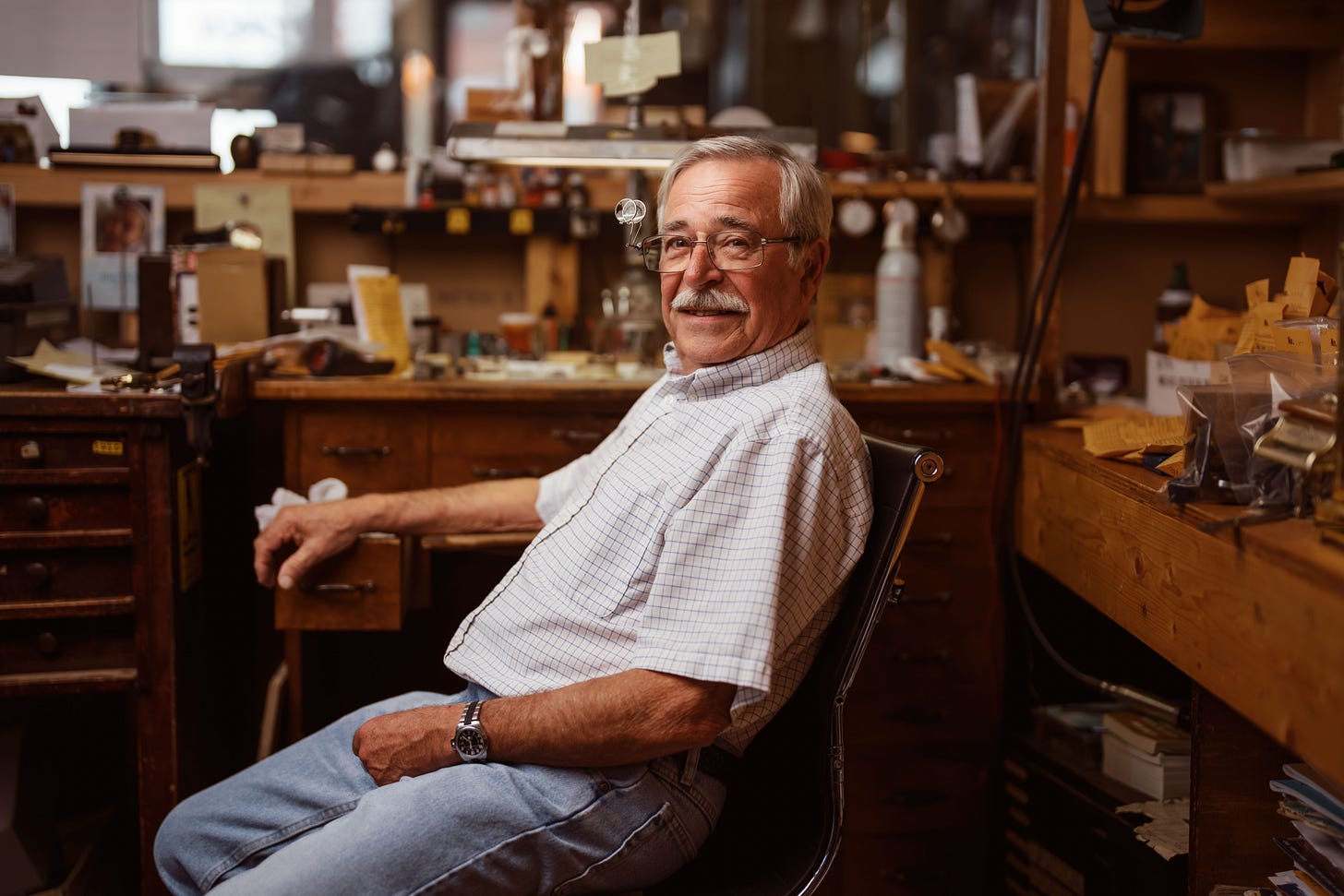The Watchmaker
“In 1973, there were probably a dozen watchmakers in the Great Lakes Bay Region, but now I'm the only one left. The Lone Ranger!
I'm third generation. My great uncle Martin Nuechterlein was a watchmaker—his picture is on the top shelf there. When he came home from World War I, he went to work for Herb Siebel, where the party store on Hamilton Street is now. That was Siebel’s Jewelers back when Hamilton was the main street, not Michigan. If you look at the front of that party store, you'll notice it's white marble from when it was a jewelry story, and I bet the walk-in safe is probably still there in the back. But Herb died of a heart attack in 1939, and so my great uncle Lance basically took over and changed the name to 'Nuechterleins'.
When my dad got home from World War II, he brought my mom home from Sioux City, Iowa, and he went to work for great uncle Lance. My dad became a watchmaker, then went on to become a GI graduate gemologist and master jeweler.
As for me, I was the kid in the neighborhood who made a go-kart with an old washing machine engine. Every kid in the neighborhood went home to get every extension cord they could find until we had enough extension cords hooked up to go up and down the entire block with it. Then I found an old Lawson lawn mower, took the motor off and put it on my go-kart so we didn’t have to use the extension cords. We lived on South Woodbridge and Bates Street was behind us and they were both still dirt roads, so me and friend Dale would go back there with my go-kart and his mini bike and run around with them. It was fun what we got away with.
So I was about 16 years old and at Arthur Hill High School when my dad said, ‘Why don't you come into the store after school and on Saturdays so Tom can show you how to fix simple clocks and stuff.’ Tom was my dad's youngest brother, my uncle, a licensed watchmaker, and, it turns out, one heck of a great teacher. He could fix anything.
He was a natural at it and the best watchmaker I ever knew.
By the time 1972 rolled around, I was working on watches, fixing everything in the store. At the time, Bulova Watch Company ran the Joseph Bulova School of Watchmaking and they were coming to Michigan for two weeks at the Marriott in Ann Arbor. My dad said, ‘You know, why don't you go to the Bulova traveling show, take your test and get your license?’
So, I did that. There I met a guy from Novi whose dad and his uncle had a really famous clock repair shop that did restorations for the Smithsonian and people like Henry Ford. We got to look at that operation, which was pretty neat.
I got my first license from Bulova in 1973, then I went back in 1976 and got my Accutron license. Bulova Accutron was a completely different kind of watch. It was a tuning fork and filled with electronics. I got my license for that at another traveling show, then I went back again and got my quartz license.”
But Dad ended up getting cerebral palsy, so he only worked for about 10 years at the shop. I’m still doing this because I like working on stuff. I'm the kind of guy who went to Delta at night during my 20s and learned how to do residential wiring just because I wanted to know how. Then I took plumbing and heating, just because I wanted to know how to do it. I wasn’t going to become a plumber or an electrician—I just like knowing how to do stuff.
And now, here I am, 71 years old, and I've got more work than I had in my entire life.
This was originally my dad's store, and when he passed away seven years ago, we discovered that he had a will and a trust. Everything was done right, except he forgot to put my name and my brother's name on the deed to the building. With that, we lost the grandfather clause on the code. The building was 100 years old and appraised at $66,000, but the estimate to bring it up to code was $100,000, meaning it was going to cost more to bring it up to code than the building was worth.
I told my son and daughter that we were going to sell the building and move. They both said, ‘Why don't you open a watch and clock shop? That's what you always wanted.’ So, I thought about it and went over and talked to Denny Whelan from the Stable and I said, ‘Denny, who owns that building?’ He told me the name, I called the guy up and said, ‘I'd like to rent your spot,’ and I did.
I changed the name from Nuechterlein's Jewelry, the name of my brother’s store on Center, to Nuechterlein's Watch and Clock.
Since I wasn't in the jewelry business, I was no longer competition to jewelers in the area so I started getting phone calls from all these stores to do their watch repair: Stan’s and Simmons Jewelers in Bay City, then my brother's shop, then a couple more in Saginaw because nobody could find a watchmaker.
And now here I am at 71 years old and I've got more work than I had in my entire life. I'm desperately trying to find a young guy or a young girl to go to watchmaking school. I need two more watchmakers, but I can't find one.
To do watch repair, you’ve got to understand the dynamics of how a watch works, because mechanical watches have made a huge comeback. Repairing a quartz watch is just taking the quartz out, throwing it away, and putting a new one in. I can teach somebody to do that in a day. Repairing a mechanical watch, though, is more difficult and it’s probably 50% of what I get in.
When you go to watchmaking school, you learn the engineering of a watch. You learn why one watch works like this and another one works like that. If it's a straight clean and oil, you don't need all that, but when it comes to diagnosing the problem a watch is having and figuring out how to fix it can take some time.
A reasonably mechanical person can finish watch school in a year. The last person I knew who went to watch school was an in-law of mine. He finished the watchmaking school in nine months. Unfortunately, he was also an excellent welder and got hired by a steel company. They offered him like $10 more an hour to start and now he's making really, really good money … so we lost him.
The closest school is in Quincy, Illinois. They'll help you arrange for a government student loan and the whole nine yards to help—because it’s not inexpensive. They'll even help you find a job while you’re there. The school runs Monday through Friday, 9-5, and it's also a work-at-your-own-pace type of an environment—almost individual instruction.
You learn the basics at school. You spend the first month or two just on tools, learning about how they work, what they're for, which kind of oil to use, how much to put on and so on. They teach you more and more, and then you can go out and do an apprenticeship.
Apprenticing at a real shop is important, because while school is where they teach you how to fix the watch movement, a shop is where you learn how to work with customers. There used to be a school in Plainwell, Michigan. We hired a guy out of Plainwell and he did excellent work, but didn't know that you've got to clean the case and band and polish them up after. School taught him how to fix watches, so that’s what he did.
But the customer sees the case and the band—they don't see the movements inside the watch.
I said, ‘Why do you think car dealers will fix your car and then wash it before they give it back to you? It's got nothing to do with that water pump repair, but customers don’t see the water pump, they see the outside of the car. It’s the same thing.
All the best watches in the world have always been mechanical. Always.
Mechanical watches are not as accurate as quartz. But a quartz watch is like a flat-screen TV: when it quits, you chuck it. But the reason mechanical watches are the best is because 450 years from now, they can be made to run again.
Take a Rolex, for instance. They’re fun to work on because they're so logically made and refined to the point where the movement is pretty much bulletproof. A watch like a Rolex Submariner is probably the most brutally tough watch money can buy: you could park a semi on that sucker and it would keep right on running.
There's only one improvement that I can see that's left to make on a Rolex. A Rolex has a weak point in its watch movement in what is called the oscillating weight: they still use a steel axle with a ruby at the top and a ruby at the bottom. But what happens is, if the axle isn’t oiled and gets dried out, the rubies will grind the heck out of it—ruby is 50 times harder than steel. Other watch companies, like Omega or Longines, use a ball bearing that's much bigger in diameter, which distributes the weight over a much larger area so they don't run into that issue, and I’d expect Rolex to decide to do the same in the future.
I went back to wearing a mechanical watch because, first of all, it ticks. It does what a watch or a clock is supposed to do. It RUNS. It's got a main spring, gears, a balance wheel that you can regulate to be fast or slow. Right now, I'm wearing a Hamilton Khaki Field Series watch: It’s self-winding and you can look inside the watch and see it tick.
A nice mechanical watch is something you can pass down. Right now, I'm cleaning and oiling a 110-year-old pocket watch and today, more people are buying watches. For keeping time, yes, but probably more for the jewelry aspect of them. They get out of college, get a good job, and turn 30 or 40 years old and want to buy a nice watch. That's when they end up buying a mechanical watch.
But like I said, anything you buy in quartz these days is super accurate and more accurate than a mechanical. Lacrosse Technologies makes a watch that's guaranteed to one second every 5,000 years!
But nobody needs a watch that accurate, and that's one of the reasons I went back to wearing a mechanical. I reached a point in my life where I said, ‘That's not something I need.’
I don't care if my watch keeps time accurately to one second every 5,000 years. My Hamilton here is off by a minute every week or so.
Guess what I do? I just reset it to my phone.
A mechanical watch works using physical energy instead of electrical energy: they have a balance wheel inside that spins back and forth to move the second hand, and that spinning is measured by beats per hour. The faster it spins, the more smoothly the second hand moves and the more accurate the watch is. Nowadays, that is all the way up over 30,000 beats per hour!
Your regular run-of-the-mill quartz watch has a quartz crystal that vibrates with a tiny electric motor. If you put electricity in the quartz, it'll vibrate at a known rate, the computer chip counts that known rate and then turns the hands of the watch accordingly. The circuit board monitors the quartz crystal. Then the motor is called a ‘stepping motor’. The circuit board that tells the stepping motor ‘...now…now…now…,’ and that's why when you look at a quartz watch, the second hand jumps in tiny ‘steps’.
Some watches are a lot easier to work on than others. You get into some of those old automatic, self-winding watches from the 1950s and they're so overly complicated. It costs way more in time to clean and oil one of them than it does to clean a modern Omega or Rolex even though they’re less expensive.
Rolex is simpler and more logically put together. They've been working with the same basic movement and just kept refining it.
The holy trinity in watchmaking are Patek Philippe, Vacheron Constantin and Audemars Piguet. They're completely handmade and absolutely brilliant. Rolex is more well-known, but you can go to one of those companies, order a watch and they will make it for you—you can't do that with Rolex.
The most expensive watch on Earth was a Patek Philippe pocket watch that sold for $12.5 million. It took three watchmakers five years to make!
The highest rating a watch can receive by the Federation of the Swiss Watch Industry is for something the owner of the watch will never see—the inside. If the movement inside the watch is finished just as nice as the outside, they receive the highest rating. Rolexes are basically a production-line watch, but hand-fitted and hand-finished and t hat's what makes them expensive. But the insides are not finished like the outsides. But every men’s watch Patek Philippe makes gets the highest certificate, and a bout half of the women’s watches get that certificate. That goes for Vacheron Constantin and Audemars Piguet, too.
I've seen probably 20 Pateks and 20 Vacherons over the years, but I've only ever had one Audemars show up in my lifetime.
I've had some other very exotic watches come in, like a Zenith El Primero. It's a men's chronograph stopwatch, automatic.
The guy who had it didn't even know what he had. The company he worked for gave it to him after 25 years of employment. He brought it in and I said, ‘Wow, that's nice!’ He said, ‘It is?’ He had no idea. I told him it was a Zenith El Primero and asked where he got it. He said his company gave it to him about five years ago when he had 25 years in.
I had to explain to him what he had and said, ‘You don't have this insured? Because you should, it's worth as much as your car!’”
—Dick Groening, owner of Nuechterleins Watch & Clock LLC
You can also connect with me on LinkedIn, Facebook, and Instagram.
















